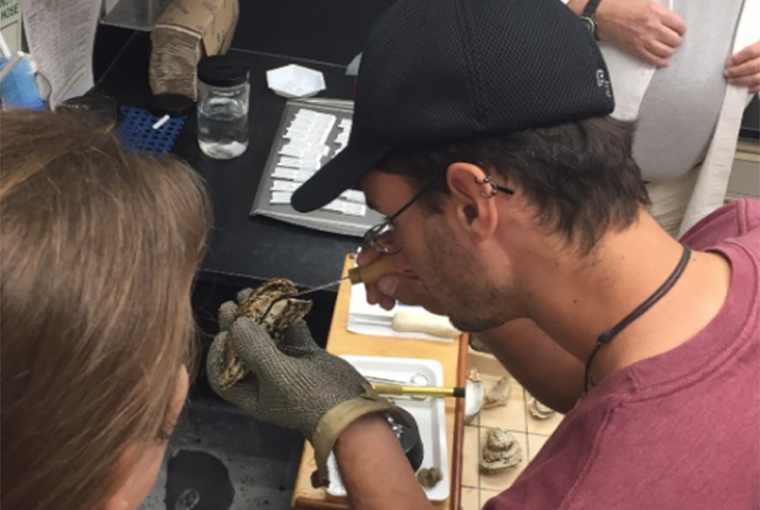Coastal Studies Students Study Chesapeake Bay Oysters

Nate Purser dissects an oyster—the first step in assessing the presence of disease in our samples.
By Drew Ferrier, Ph.D., Professor of Biology and Director of the Center for Coastal and Watershed Studies
The oysters of the Chesapeake Bay are an important commercial species, a linchpin in the waterman’s livelihood, and a keystone organism in the Bay’s ecology. Unfortunately, for the last three decades oyster populations have declined to an estimated one to two percent of historic levels. One reason for the decline is parasitic disease that can be lethal to oyster populations already under environmental stress.
Last week the students enrolled in our Coastal Studies Semester spent time at the Oxford Cooperative Laboratory on Maryland’s Eastern Shore to learn more about these diseases and the methods that are used to study them. Chris Dungan, a pathologist and research scientist at the lab, provided an overview of the parasites inhabiting oysters, their life histories, and the impacts that they have on the Bay’s oyster populations. Following this introduction, the students began a morning of hands-on learning in the histology laboratories operated by Chris’s team of biologists and technicians. Students were able to take part in the processing of oysters to assess disease prevalence and intensity.
We began by dissecting recently collected oysters and sampling their tissues for closer inspection for the presence of parasites. Tissues were fixed, dehydrated, and then the students embedded each sample in paraffin wax in order to make very thin sections of the tissue for microscopic examination. These thin sections were mounted on microscope slides and stained to more easily visualize the tissue samples. Later we gathered around a video screen to view micrographs of the completed tissue preparations. Chris provided us an analysis of representative samples by pointing out anatomical structures and the parasites infecting each oyster.
It was a great experience for the class and one that will have a real-world application. In a few weeks the class will be exploring the Patuxent River estuary on the Bay’s Western Shore. The students will be sampling Gatton bar, an oyster reef on the river bottom, and be conducting their own assessment of oyster diseases at that location.
- Undergraduate
- Center for Coastal and Watershed Studies
- Natural Sciences




